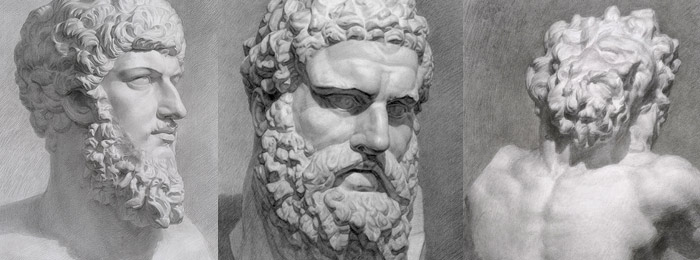Plan to Learn How to Draw

Question from Slater Smith
For the past month, I accept been in something of an creative heat. I cannot call it a creative block, because I go ideas all the time. I just don't have the technical ability to execute them.
So my question is, how exactly should I written report drawing? Maybe focus on one for say a month, then movement on to the next area? Or should I study two subjects that are closely related, like architectural drawing and perspective?
Thanks for your time,
Slater
Feedback from Vladimir London, Drawing University Tutor
Dear Slater,
Many thanks for your question.
Your challenge is non unique. It mostly comes from the fact that you lot have to learn art skills on your own but do have not found a proper structure in which to do it.
I'll tell you my experience; hopefully y'all volition detect it helpful.
I take been cartoon for as long as I tin can retrieve. From a very early historic period, I wanted some fashion to express myself creatively, fifty-fifty though I didn't really empathise that desire. My female parent took me to various craft studios in the hope I would find a good place to pursue my passion.
Every studio I went was no more than an "limited yourself" fourth dimension waster, pretty much similar some contemporary fine art colleges today : )
One day, a new art school opened nearby. Information technology was a no-nonsense professional art establishment for secondary school children. It even had archway exams! I was only 9, likewise immature to enroll officially, just the schoolhouse accepted me on the condition that I would spend 2 years in one course class, the youngest historic period category.
Information technology was a proper art instruction. I spent the next five years studying and practicing fine art for four hours every day. The curriculum included just six subjects – classical drawing, traditional painting, history of arts, sculpture, composition, and decorative arts. This school had professional artists with teacher's degrees. Art educational activity progressed gradually from the nuts to more than advanced lessons, step-by pace.
I was just following the programme they had in place: cartoon and painting still-lifes and models, creating compositions, practicing sculpture and decorative arts, learning the history of fine art. No heat, no creative blocks. The teachers had a program that stated the subject of the course, its objectives, and the time limit. We students had assignments, deadlines, and internal and external exhibitions. This school laid a swell foundation that helped me to enter another two art universities and graduate with distinction.
The point I'm illustrating here is that to attain meaningful results, you need to take a good program in place. You already know what fundamentals are required to develop good drawing skills. Now, it is a affair of organizing your learning schedule.
I will outline some primal points of your cartoon pedagogy in sequential social club. You lot can assign the time you demand to master them:
one. Understand the cartoon materials, arrange your working space, practice holding a pencil in correctly. All of this is quite straightforward, except for the proper way of holding a pencil. Yous may bank check the Cartoon Academy video lessons on this subject and, and then to speak, get a proficient grip!
2. When you are ready to use a pencil, continue with the absolute basics – cheque this video to get started, and follow its steps:
//drawingacademy.com/aid-i-cant-describe
Don't be discouraged by the simplicity of the suggested exercises. Although this video was created for complete beginners, even some art college graduates practise not always have the necessary skills and take benefitted from its lessons.
iii. Continue with one- and two-indicate perspective. The Drawing Academy video lessons and bonus materials deliver all you demand to know on this topic. A deep understanding of these 2 perspective types is necessary, as they will underpin 90% of what you must do in perspective drawing. When you are set, continue with aeriform perspective, which will encompass the remaining 10%. It is too skillful to know three- and four-signal perspective, too equally perceptive perspective. A Drawing Academy bonus video covers these boosted topics well.
iv. Equipped with the noesis and practice of perspective, keep to effective drawing principles. Describe simple geometrical still-lifes: interiors and exteriors. Practice not worry about shading tonal values at this step, that will come later. Even if you do a perfect tonal rendering of a desperately constructed drawing, the event will still be inferior. Develop your ability with constructive drawing outset.
5. With fourth dimension, when your constructive drawing skills improve, begin practicing rendering tonal values. Just first this procedure when you feel comfortable with your abilities with all the previous steps and tin can incorporate them into every cartoon that y'all brand.
6. Keep with figurative cartoon. First, larn human body proportions. The Drawing Academy video lessons give very comprehensive data on this subject. As well, I'm currently working on new video lessons dedicated to human torso proportions and anatomy for fine artists.
7. Practice sketching gestures; that is, human figures in diverse poses. Observe people around y'all, draw figures from memory, and imagine human characters that you tin can depict. Use the rules of homo proportions that you learned previously.
8. Study the anatomy of the human head. Beginning with a skull. Draw information technology repeatedly, from various points of view, until you can draw information technology from imagination at any possible angle. You will know you are ready when you can draw the skull from an angle y'all have never practiced before straight from your imagination.
nine. Brainstorm to larn the head muscles – time to put some flesh on the bones : ) Not every muscle in the head volition influence its appearance; written report only those that brand a deviation.
10. Larn the proportions of the human caput and face. This cognition is indispensable when it comes to drawing portraits from life, retention, and imagination.
xi. Practice constructive cartoon of a human caput. One time again, tonal rendering is not required for this footstep. You want to learn how to "build" a head co-ordinate to its beefcake and proportions. Don't forget the perspective rules!
12. Aggrandize your portrait drawing skills with tonal rendering. Larn the stages of portrait cartoon intimately. They are described thoroughly in several Cartoon Academy video lessons.
13. Learn the skeletal anatomy of the man torso. For you as an creative person, information technology is not necessary to learn every os in the trunk and all their Latin names! Focus on those that are essential to the advent of the homo body.
xiv. Learn the musculature of the human being torso. This could exist done simultaneously while you larn skeletal beefcake.
15. Practise constructive drawing of the man trunk and its parts. Draw from classical sculptures, as well as from life, memory, and imagination. Worry about tonal rendering later; emphasize first your figure proportions and proper construction.
xvi. Go on by cartoon human figures with tonal rendering. All the previous points need to be mastered – proportions, perspective, constructive drawing, and anatomy. Only when all these different pieces are in place will you be able to achieve realistic, correctly drawn, believable figurative drawings.
17. Acquire the rules of composition. Everything that has been learned thus far can be put in ane identify by the utilise of skillful composition. Figurative artworks, yet-lifes, landscapes—in fact, annihilation y'all draw will merely look good if you compose your artwork correctly.
18. Develop a solid agreement of the Golden Proportion. This is the ratio that rules the world. Human body proportions, nature, human-made objects, cute compositions – all wait good for a reason. The secret is the Golden Proportion. In the Drawing Academy class, you will find video lessons on the Golden Proportion, what it is, and how to apply it in your compositions.
This is not an exhaustive listing of the drawing disciplines you need to master. By the mode, the only drawing materials you need to practice all eighteen points to a higher place are graphite pencils, drawing paper and an eraser : )
By time you finish these exercises, you will find that there are many other creative avenues you lot may want to pursue. You may wish to primary different drawing media, like metal-indicate, pen and ink, and colored pencils. You lot tin can learn the techniques of figurative drawing that were used by the Old Masters. Yous may desire to amend your speed-cartoon skills. In that location are countless different fields you tin explore once you lot chief the basics; for at present, you have a very comprehensive list of steps to go through as you get started.
As for how long information technology takes to master those skills, the truth is, it depends. Don't look to reach mastery past spending an 60 minutes or two on each step. Information technology took me v years to get the basics correct : )
Dedicate equally much time as y'all can to practice. Principal every signal before continuing to the side by side one, and follow the sequence recommended above.
You tin can simply achieve proficient results in figurative cartoon when you build your skills on a solid foundation – in this case, human beefcake and constructive drawing. Constructive cartoon, however, requires that you also learn the rules of perspective beforehand.
Thank you for your drawing! I similar it, although information technology has needs some comeback (in constructive cartoon and anatomy, for example). I want y'all to take few steps back and beginning from the basics. When you beginning working on portrait drawing, we volition hash out this subject once again : )
I hope this was helpful.
Please allow me know if you have any questions.
To your artistic success,
Vladimir
Enroll in the Drawing University Grade:
Pay for the course in 3 piece of cake installments
- Receive 15 new videos monthly (45 in total)
- Incredible discount – $4,164
- Bonuses - Fine art eBooks and Videos
- Drawing Academy Diploma of Excellence after class completion in 3 months
- Personal coaching by Drawing Academy Tutors
- Lifetime membership. Gratuitous later the third month
Total cost: $291 USD (3 x $97)

Go all video lessons for a one-fourth dimension payment
- Immediate access to all 45 video lessons
- Incredible disbelieve – $4,198
- Bonuses - Fine Art eBooks and Videos
- Drawing Academy Diploma of Excellence after course completion in 3 months
- Personal coaching by Drawing Academy Tutors
- Lifetime membership. No more payments
Total price - Merely $257 USD

Source: https://drawingacademy.com/how-should-i-study-drawing
0 Response to "Plan to Learn How to Draw"
Post a Comment